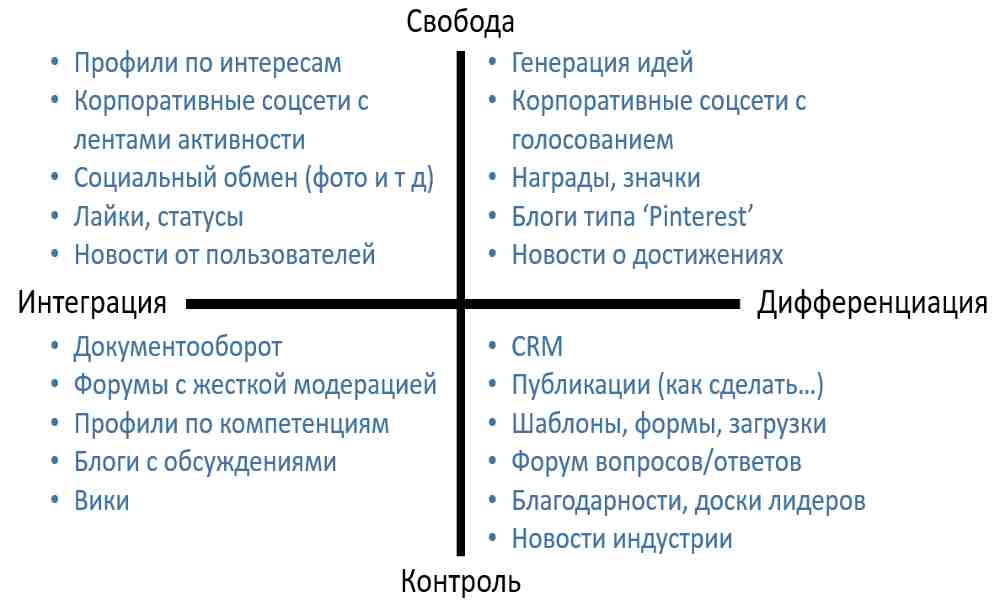Why Yammer works for others, but not for you
Different organizations have different cultures for working together. Collaboration tools also have a different philosophy. How to choose the right tool for a given corporate culture?

Imagine what I told you about how I had a wonderful vacation at sea. Inspired, you will go to the same place, stay at the same hotel, go to the same restaurants. But your family will be disappointed. Why? Because it is different, maybe your relatives love wild leisure or sports tourism.
So it is with social communications. For each success story, there are a dozen companies that are trying to do the same trick, and their undertaking fails miserably.
The reason why collaboration does not take root lies in the fact that different work tools basically have a different philosophy. For this reason, Yammer works in some organizations and does not work in others. To deal with this, you must first understand a little about the culture of collaboration.
Different types of orientation of organizational cultures can be depicted on the graph: The

vertical coordinate determines the degree of transparency of information - from tight control to free distribution.
The horizontal coordinate determines the preference - either to combine information with the one that already exists, or to look for something new in it. For example, does your organization focus on what is happening inside it (integration) or what is happening on the market (differentiation)? Or, what is more important for you, that a new employee quickly joins the team and shares existing values and norms of behavior in the organization, or that he brings new experience and new approaches to work?
Each quadrant defines its own culture.
InnovationCompanies are focused on novelty, they are flexible and easy to change. Startups or developers of new gadgets are typical examples. When you ask a question, you are likely to hear something like “Let's brainstorm” and get five ideas that no one has tested in practice.
Results. A culture of goal achievement is what distinguishes such organizations. These are companies aimed at sales or serious marketing, they know and highlight their competitive advantages. But they want their idea to be consistent, so a typical answer to the question may sound like this: "Here is a standard presentation, use it in all commercial offers."
Information control.A culture dominated by formal rules, policies and standards. Everything new must merge into the existing. Such a culture takes place in highly regulated areas where the reliability of information is paramount, for example, in reputable financial institutions with a century of history or in nuclear power plants. A typical answer is: “Follow procedure 10076b, current version 2.1.1.”
Relationships. It is a culture focused on people and cohesion. It occurs in organizations where involvement and harmony are important, for example, retail chains or fan clubs. They will answer your question: “You need to ask Vasya, he must know. Let's go get some coffee and I'll introduce you. ” Note: instead of coffee, there may be any other drink appropriate to the organization.
So, for each culture, there are the most suitable tools for collaboration:

In large organizations, cultures of different divisions may vary, but in general people of the same organization have approximately the same expectations of how they will work together and agree, i.e. Each organization has its own dominant. What happens if the collaboration tool does not fit the quadrant - will it change the corporate culture? If both initially do not fit together, most likely the tool will simply not be used. If the organization directs significant efforts to change its culture, then yes - the tools of collaboration will help in this, but they themselves will not change the culture.
It can be seen that different software products fall into different quadrants. For example, SharePoint has its roots in teamwork with documents. In versions 2010 and 2013, they tried to make it socialized, but I would not call these attempts successful. Because the product was originally based on a philosophy of controllability. And therefore, if you need openness, it is better to use a bunch with Yammer.
Or, for example, Jive Software. Roots it grows from the upper quadrants, but at the same time has learned to mimic well under an environment where there is only one version of the truth. Although our recent experience with Jive suggests that right now it is right in the middle of the table and has an almost perfect balance between openness and confidentiality.
Therefore, when implementing collaboration tools, it is necessary to understand the features of organizational culture and the philosophy of software products. So, if you suddenly begin to bang your head about the rejection of users, ask yourself how the instrument and culture of the organization relate to each other. And if not, maybe it's time to think about a vacation at sea?
Written based on Why Collaboration Works for Others, But Not for You.
Vladimir Ivanitsa Facebook | LinkedIn

Imagine what I told you about how I had a wonderful vacation at sea. Inspired, you will go to the same place, stay at the same hotel, go to the same restaurants. But your family will be disappointed. Why? Because it is different, maybe your relatives love wild leisure or sports tourism.
So it is with social communications. For each success story, there are a dozen companies that are trying to do the same trick, and their undertaking fails miserably.
The reason why collaboration does not take root lies in the fact that different work tools basically have a different philosophy. For this reason, Yammer works in some organizations and does not work in others. To deal with this, you must first understand a little about the culture of collaboration.
Different types of orientation of organizational cultures can be depicted on the graph: The

vertical coordinate determines the degree of transparency of information - from tight control to free distribution.
The horizontal coordinate determines the preference - either to combine information with the one that already exists, or to look for something new in it. For example, does your organization focus on what is happening inside it (integration) or what is happening on the market (differentiation)? Or, what is more important for you, that a new employee quickly joins the team and shares existing values and norms of behavior in the organization, or that he brings new experience and new approaches to work?
Each quadrant defines its own culture.
InnovationCompanies are focused on novelty, they are flexible and easy to change. Startups or developers of new gadgets are typical examples. When you ask a question, you are likely to hear something like “Let's brainstorm” and get five ideas that no one has tested in practice.
Results. A culture of goal achievement is what distinguishes such organizations. These are companies aimed at sales or serious marketing, they know and highlight their competitive advantages. But they want their idea to be consistent, so a typical answer to the question may sound like this: "Here is a standard presentation, use it in all commercial offers."
Information control.A culture dominated by formal rules, policies and standards. Everything new must merge into the existing. Such a culture takes place in highly regulated areas where the reliability of information is paramount, for example, in reputable financial institutions with a century of history or in nuclear power plants. A typical answer is: “Follow procedure 10076b, current version 2.1.1.”
Relationships. It is a culture focused on people and cohesion. It occurs in organizations where involvement and harmony are important, for example, retail chains or fan clubs. They will answer your question: “You need to ask Vasya, he must know. Let's go get some coffee and I'll introduce you. ” Note: instead of coffee, there may be any other drink appropriate to the organization.
So, for each culture, there are the most suitable tools for collaboration:

In large organizations, cultures of different divisions may vary, but in general people of the same organization have approximately the same expectations of how they will work together and agree, i.e. Each organization has its own dominant. What happens if the collaboration tool does not fit the quadrant - will it change the corporate culture? If both initially do not fit together, most likely the tool will simply not be used. If the organization directs significant efforts to change its culture, then yes - the tools of collaboration will help in this, but they themselves will not change the culture.
It can be seen that different software products fall into different quadrants. For example, SharePoint has its roots in teamwork with documents. In versions 2010 and 2013, they tried to make it socialized, but I would not call these attempts successful. Because the product was originally based on a philosophy of controllability. And therefore, if you need openness, it is better to use a bunch with Yammer.
Or, for example, Jive Software. Roots it grows from the upper quadrants, but at the same time has learned to mimic well under an environment where there is only one version of the truth. Although our recent experience with Jive suggests that right now it is right in the middle of the table and has an almost perfect balance between openness and confidentiality.
Therefore, when implementing collaboration tools, it is necessary to understand the features of organizational culture and the philosophy of software products. So, if you suddenly begin to bang your head about the rejection of users, ask yourself how the instrument and culture of the organization relate to each other. And if not, maybe it's time to think about a vacation at sea?
Written based on Why Collaboration Works for Others, But Not for You.
Vladimir Ivanitsa Facebook | LinkedIn
